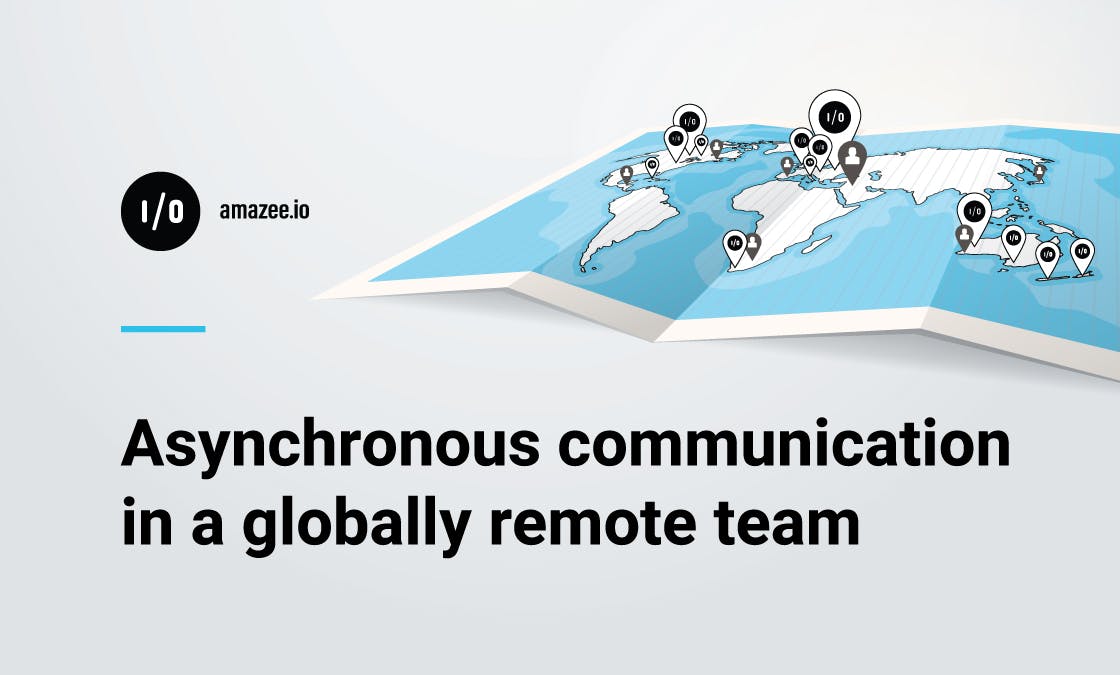Matthew Smith
|
Sep 02, 2021
|7.5 min read
Search Topic

Time zones can be difficult, whether it's video calling family on the other side of the world or causing so much frustration to a whole country that they change theirs to that of a neighbour’s (we feel you, Iceland). They can be a pain.
When it comes to business, however, being able to work across multiple time zones, especially being a web services provider like ourselves, is really useful, and necessary. We need to be operational and be able to attend to our clients 24/7, and we want to have the diversity of thought and culture which make ideas happen, and life more interesting. All of these are reasons we have a global, fully remote team to keep the ship sailing smoothly.
This has real advantages for us (more on that here). However, it can come with challenges too. We have to consider the fact that as humans, we need sleep, and a life, so we can’t work in a manner that requires people to be available constantly in real-time. Managing daily business in a team across all time zones requires us to look at teamwork, communication, and operations a bit differently. We need to be able to work asynchronously.
What is it?
Asynchronous communication is the art of being able to work and progress tasks without needing each stakeholder present, and without losing efficiency. Doing it well can benefit almost all organisations, whether it be a multi-floored office, co-located teams, or fully distributed teams (in which case, it’s vital).
Asynchronous working is not new. Anyone who has ever sent an email, or left a Post-It note on someone’s desk has been working asynchronously. It's something we are all used to. However, being a worldwide remote team, we have to incorporate it into our processes and mentality. When working asynchronously, you have to always consider, “How would I complete this task, or move forward with this project, if all of my colleagues were away?”
Set expectations
Setting expectations is the fundamental step to working across multiple time zones. All team members should be encouraged to set their boundaries when it comes to how late or early they are able to attend meetings, and it needs to be made clear to them that with asynchronous working, immediate responses aren’t expected to instant messages or email. Without this clarity, you run a very real risk of burnout in your team.
It’s natural for people to hear a ping, and respond to it. In a global organisation, with pings from different time zones, this can make it impossible to switch off. Team members should be encouraged to turn off their notifications outside of their work hours, and processes and tools need to be used which replace the need for urgent or real-time feedback from peers.
Another expectation that allows asynchronous working to really flex its muscles is that of autonomy. You don’t want to delay things unnecessarily whilst your team waits for a colleague on the other side of the world to wake up. Give your team freedom to make their own educated decisions on projects and to prioritise their own tasks. You’ll avoid delays that come without this freedom.
In fact, setting these expectations could also result in some added advantages—most significantly, employee wellbeing.
Synchronous communication requires you to have either people available all of the time, or that the whole team works the same hours.
When you don’t have that expectation, the team can work hours that suit their schedule and life. It also means there is less pressure to be constantly on the ball, and with no expectation of immediate answers, they have fewer distractions and have more control over their workday.
Documentation and communication
When it comes to asynchronous working, these two are essentially the same thing. To communicate asynchronously means to document something, somewhere.
It’s best to apply a policy of precise and direct communication. Give as much context as possible in communications or in updates to projects, etc. and encourage your team to anticipate feedback and questions to their communication and address it upfront. This also helps avoid the annoying back-and-forth which can happen with asynchronous communication across time zones.
One simple way we can do this is to ask ourselves, “If someone was looking at this update for the first time, having just joined the company, would they understand what was going on?” If communication is clear for someone who lacks any previous context outside of the trail of documented communication, then it's good communication.
Documentation means that you have a knowledge trail. This can mitigate future delays or errors, and avoid confusion. You’ll have an information base for each project and task and won’t lose context if someone leaves. It also means that new joiners can quickly get up to speed. All of this gives us more time to be more productive (and send GIFs).
It also makes us more considered in what and how we communicate, promoting a solution based mindset. When considering potential feedback upfront, you are more likely to find a problem to solve and not develop the habit of seeking immediate feedback from colleagues just because it’s easier.
Tools
Tools are our friends. Having the correct software or apps in place makes a huge difference.
Tools need to be carefully selected, and it works best when you have as close to “a single source of truth” as is feasible. Try to channel all information relating to certain projects through one platform. This makes it much easier for colleagues to progress, update, and track tasks, without the need for real-time communication.
We are a “paperless” company, which is a necessity when working across different time zones. Google Drive is our answer to this. Any document anyone might need should be stored digitally, where they can access it without bothering a colleague at an unsuitable time for a certain contract or invoice.
Project management tools are used to great effect. In our internal operations, we use Monday.com. It allows us to update projects, team tasks, and meeting agendas clearly and easily, meaning they become the first port of call when checking for status updates or task progress and history rather than chasing a colleague or searching through emails or months of old messages.
Not least you’ll need a company-wide communication platform. We use Slack. This is our most frequently used platform for async communication. It’s where all announcements and company updates are communicated, and it’s where decisions are most often made.
By using a written communication platform for announcements, to drive debate, and make decisions, it’s easier for everyone to be involved and aware of things whilst working distributed. We also link our project management tools to Slack so that updates and progress are automatically communicated in project or team specific Slack channels.

Limit, but don’t kill meetings
100% asynchronous working is perfect... for robots. However, it’s not great for those who have emotions and social needs, e.g. every human.
One thing we definitely don’t recommend is to remove as much face-to-face interaction as you can and make everything about updating tasks lists and sending messages.
Limiting meetings, or at least restructuring them, is a practical step within a distributed setup.
We have teammates from New Zealand, to England, to the US. This means we rarely communicate through one company-wide meeting, and it should hopefully be obvious by now that one of the benefits of asynchronous communication is that you don’t have to rely on face-to-face meetings.
We do have face-to-face meetings and it’s still a large part of how we communicate with each other—we don’t want to lose the human element that makes us enjoy working with our colleagues.
To accommodate a worldwide team, meetings can be split between time zones. For example, amazee.io has 3 social stand-ups a day, at times which mean at least 2 of the regions can join each meeting during their workday. We have a similar set-up for company-wide meetings and project teams.
There is a practical requirement sometimes to schedule meetings for less ideal hours. This flexibility can sometimes be needed for a distributed team, but this should always be within reasonable hours. Acceptance shouldn’t be assumed; it should be checked for any colleagues which would be attending these meetings outside of their preferred work hours.
A final note on Etiquette
Small things can make a big difference, so we have some basic methods for allowing our distributed team that little bit more comfort working across this big blue thing we call home.
Working in a distributed environment comes with lots of advantages to a business, including its innovation and culture. To do it effectively whilst protecting employee wellbeing requires the art of asynchronous communication. There is always room for innovation and improvement, but it's fundamental to how we operate.
Like the sound of how we work? Get in touch with us. We’d love to hear from you!

